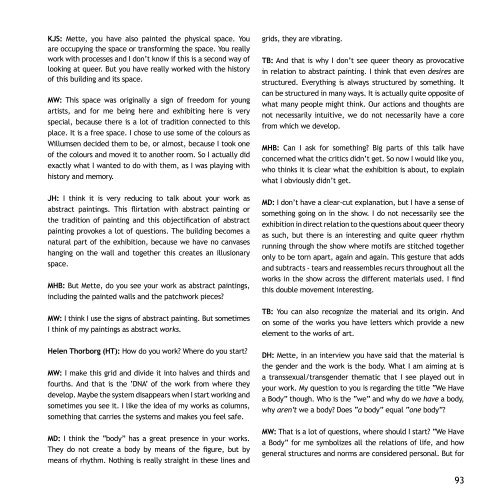læs bogen her - Den Frie
læs bogen her - Den Frie
læs bogen her - Den Frie
You also want an ePaper? Increase the reach of your titles
YUMPU automatically turns print PDFs into web optimized ePapers that Google loves.
KJS: Mette, you have also painted the physical space. You<br />
are occupying the space or transforming the space. You really<br />
work with processes and I don’t know if this is a second way of<br />
<br />
of this building and its space.<br />
MW: This space was originally a sign of freedom for young<br />
artists, and for me being <strong>her</strong>e and exhibiting <strong>her</strong>e is very<br />
special, because t<strong>her</strong>e is a lot of tradition connected to this<br />
place. It is a free space. I chose to use some of the colours as<br />
Willumsen decided them to be, or almost, because I took one<br />
of the colours and moved it to anot<strong>her</strong> room. So I actually did<br />
exactly what I wanted to do with them, as I was playing with<br />
history and memory.<br />
JH: I think it is very reducing to talk about your work as<br />
<br />
<br />
<br />
natural part of the exhibition, because we have no canvases<br />
hanging on the wall and toget<strong>her</strong> this creates an illusionary<br />
space.<br />
MHB: But Mette, do you see your work as abstract paintings,<br />
including the painted walls and the patchwork pieces?<br />
MW: I think I use the signs of abstract painting. But sometimes<br />
I think of my paintings as abstract works.<br />
Helen Thorborg (HT): How do you work? W<strong>her</strong>e do you start?<br />
MW: I make this grid and divide it into halves and thirds and<br />
<br />
develop. Maybe the system disappears when I start working and<br />
sometimes you see it. I like the idea of my works as columns,<br />
something that carries the systems and makes you feel safe.<br />
MD: I think the “body” has a great presence in your works.<br />
<br />
means of rhythm. Nothing is really straight in these lines and<br />
grids, they are vibrating.<br />
TB:<br />
in relation to abstract painting. I think that even desires are<br />
structured. Everything is always structured by something. It<br />
<br />
what many people might think. Our actions and thoughts are<br />
not necessarily intuitive, we do not necessarily have a core<br />
from which we develop.<br />
MHB: Can I ask for something? Big parts of this talk have<br />
concerned what the critics didn’t get. So now I would like you,<br />
who thinks it is clear what the exhibition is about, to explain<br />
what I obviously didn’t get.<br />
MD: I don’t have a clear-cut explanation, but I have a sense of<br />
something going on in the show. I do not necessarily see the<br />
<br />
<br />
running through the show w<strong>her</strong>e motifs are stitched toget<strong>her</strong><br />
only to be torn apart, again and again. This gesture that adds<br />
and subtracts - tears and reassembles recurs throughout all the<br />
<br />
this double movement interesting.<br />
TB: You can also recognize the material and its origin. And<br />
on some of the works you have letters which provide a new<br />
element to the works of art.<br />
DH: Mette, in an interview you have said that the material is<br />
the gender and the work is the body. What I am aiming at is<br />
a transsexual/transgender thematic that I see played out in<br />
<br />
a Body” though. Who is the “we” and why do we have a body,<br />
why aren’t we a body? Does “aone body”?<br />
MW:<br />
a Body” for me symbolizes all the relations of life, and how<br />
general structures and norms are considered personal. But for<br />
93



